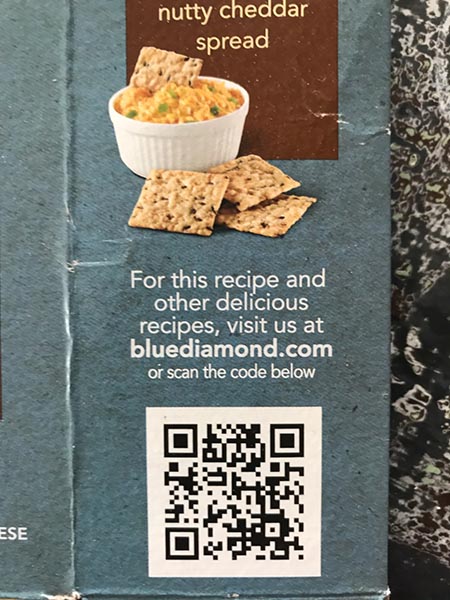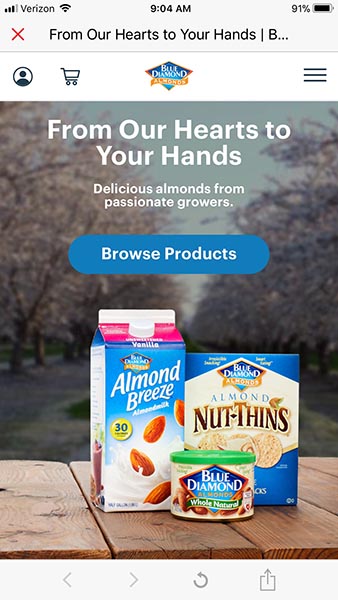QR Codes continue to pop up in new places. Most recently, we can add Blue Diamond Growers’ Nut Thins to the list. The back of the box prominently displays a yummy looking “nutty cheddar spread,” served with Nut Thins, giving shoppers who might be unfamiliar with the gluten-free crackers a reason to test them out. A QR Code is prominently displayed underneath the picture, with the invitation for shoppers to scan the code to obtain the recipe.

Here are two reasons this QR Code should, in fact, work fabulously:
- This is a relevant use of QR Codes. Nut Thins are a specialty product, and the average consumer might not expect them to taste good or know what to do with them. Newcomers to gluten-free eating, in particular, might be looking for ways to use the crackers that they actually like. Offering shoppers recipe ideas is a smart strategy that gives shoppers a reason to give the crackers a try.
- The QR Code is prominently displayed. Instead of hiding the code in a corner to prevent it from “messing up the design” (the result of which is that consumers could easily miss the code altogether, rendering it useless and giving the marketing team the excuse to say, “See? QR Codes don’t work!”), this code is displayed prominently underneath the recipe. It is large enough to draw attention, and the call to action and value to the shopper are clear.
However, there is one (huge) reason that the implementation still fails:
The QR Code doesn’t lead to the recipe. It does lead to an easily navigable mobile site that offers promotional information on almonds, a company history, information on other Nut Thin products that might not be carried on the shopper’s local retail shelf, and a shopping cart. What it doesn’t include, it seems, is the recipe that shoppers wanted in the first place.
 Thus, the QR Code delivers disappointment, not on its promise, but that is not the fault of the QR Code. It’s the fault of a marketing team that didn’t think through the customer experience.
Thus, the QR Code delivers disappointment, not on its promise, but that is not the fault of the QR Code. It’s the fault of a marketing team that didn’t think through the customer experience.
When your client brings you a project with a QR Code on it, take the time to ask the question: “Have you scanned this code yourself? Have you made sure that it delivers on its promise?” It’s a simple question, and one that could save your client embarrassment and missed opportunity.















Discussion
By Gina Danner on Apr 04, 2018
Ahhh... the QR Code... it could have been AMAZING, but too often, just as in the recipe debacle, they fail to deliver the user to the promised value. Fool me once, shame on you... fool me twice, I'm not going to bother. There we have the decline of the QR Code. In a store, you scan the code on teh package to get more information, and instead of getting product info, you land on the home page?!?!? AND, I contend, it will likely be the same thing for Augmented Reality.
Hear me out... In order to properly pull off AR it is a big commitment for the marketer -- strategy, time and budget. On top of that, it is a big commitment for the user. They have to download an app, then use their phone... good golly, is it happy hour yet...
Alas, they get things working and they get delivered to a promotional video. Disappointment ensues and we will have another great technology that fails to deploy to the level of promise.
I implore you... do not let your customers "try AR" without the right budget and strategy. Everyone will be disappointed.
Where's that cocktail?
By Edwin Acevedo on Apr 04, 2018
You will satisfy more customers with QR codes when you can offer more than one thing to choose from. One size does not fit all. It’s now possible for QR codes to deliver a smartphone experience that resembles “local search” from printed labels and packaging. For Blue Diamond, this experience can include multiple, contextual options like recipes, coupons, co-branded promotions, loyalty rewards, FAQs and more. You can even put the home page in there, if you want.
Apple removed the friction to QR code scanning by installing a scanner in the camera. Google added a QR code scanner to Google Assistant, which ships on Android phones with Nougat/Oreo+. And Phy fixes the user experience with previews of possible options. The content owner gets a feedback loop and direct attribution that leads to better visibility on what people value when your product is in hand.
By Heidi Tolliver-Walker on Apr 05, 2018
I guess I'm an oddball, but I don't see QR Codes as clunky and hard to use. I open my QR reader just like any other app, then hold the camera over the code. It's no more difficult than opening any of the myriad other apps on my phone. In some ways, it's easier. I continue to scan QR Codes because some of them are actually useful. Sure, it's a needle in a haystack, but when I do find one that's useful, it's a nice surprise. It's worth the 15 seconds it took me to check. But then, that's me. I'm weird, I guess.
By Gina Danner on Apr 05, 2018
Heidi, sorry if my post was confusing... QR Codes are easy... for anyone that is somewhat technically inclined (and you don't have to be a lot that is for sure) but for the average person, if you bother to scan one several times and it ends up taking you to and irrelevant experience, people will stop using them.
I have purposefully asked consumers at all ends of their experience level about them, granted my research is anecdotal, the general consensus is typing in a short (branded) URL is easier. At least it was for the slightly older portion of the people I spoke with -- aka OLDER meant typing -- younger meant scanning the QR code.
My concern with AR is that the creation of a good experience will drive toward adoption of the technology by the consumer. My fear is the more bad or less than promised experiences people have the longer it will take to create adoption and the lower the engagement rates will be.
My opinions and observations... I hope I'm wrong.
By Edwin Acevedo on Apr 05, 2018
With Apple and Google making it possible (and easier) to scan QR codes without a dedicated scanner app, it would seem to me that non-app solutions are the way to gain traction moving forward. And I believe the likelihood of delivering useful information after a QR code scan increases when there are several options to choose from, rather than a single link. QR codes will succeed when the experience feels more like customer service and less like an advertising afterthought.
By Matt Buker on Apr 09, 2018
I truly believe the QR code is the fastest and best way for customers to intersect print and digital. As Edwin points out, it is easier then ever. In the fall Apple snuck the reader directly into the camera, so no more third party app. Brilliant, but is it to late? Have people given up on the QR code before it had a chance, just because it was painful, or perhaps painfully easy. It's hard to communicate to just iPhone users, that the pain point has been removed, but that Android users still have an extra step. I believe we as printers and print sales folks should be sounding the horn on this, but is it to late???
Discussion
Only verified members can comment.